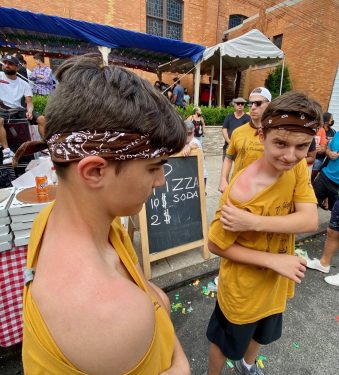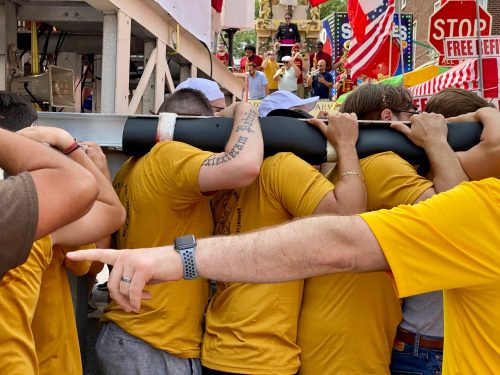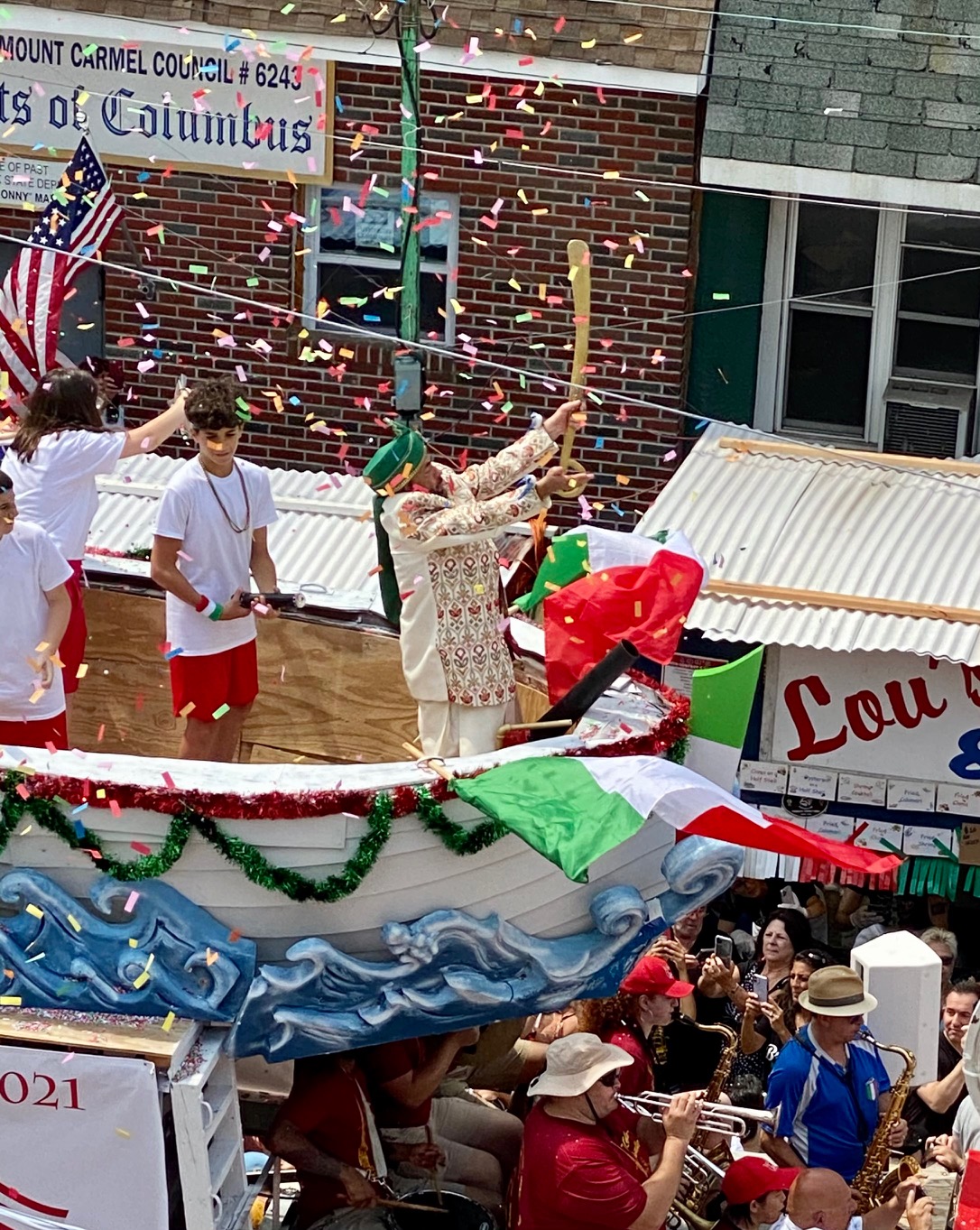By Emily Drooby and Bill Miller
WILLIAMSBURG — Dominic and Michael Franco had certainly been out of their comfort zone, and they had the marks to prove it.
On Sunday, July 11, the brothers tugged at the collars of their sweat-drenched yellow t-shirts to proudly show how their necks and shoulders radiated the fiery color of sunburn. But this redness wasn’t from harmful rays.
The teenagers had just joined dozens of men of all ages parading two massive floats on their shoulders, including the multi-story-high “Giglio” tower. The meeting of the ornately decorated tower and the replica boat comprise the “Dance of the Giglio” — the centerpiece ritual of the Feast of Our Lady of Mount Carmel & San Paolino Di Nola (St. Paulinus of Nola).
Italian immigrants and their descendants at Our Lady of Mount Carmel Parish in Williamsburg have celebrated this Italian-American classic since the late 1880s. That is, except for 1945 because of World War II and 2020 during the COVID-19 pandemic.
But on Sunday, thousands of people packed North 8th Street outside the church for the feast’s return to the Brooklyn neighborhood. Traditional Italian music, the aroma of grilled festival foods, and the rumbling of carnival rides filled the air.
It was the first time Dominic and Michael were among the “lifters,” following in the steps of their father, Philip Franco, a deacon for the parish and a lifelong resident of the neighborhood. They started the day lifting the boat and expected to switch over to the tower later in the day.
“It was like I thought it would be,” said 13-year-old Michael. “I was anticipating it was going to be a little easier in the beginning and then harder as you go on because everyone’s getting tired. Most of the lifters are, like, coming in and out. They’re taking breaks.”

Worth the Pain
In the dancing of the Giglio, the replica boat symbolizes the return of 5th-century bishop, St. Paulinus, to his beloved Nola, Italy, following his release from slavery.
Nearby, another crew was lifting the “Giglio” — a massive, ornately decorated tower symbolizing the affection citizens Nola felt for their bishop. St. Paulinus had exchanged his freedom for the release of women and children kidnapped by Vandal raiders and sold into slavery in Africa.
“Giglio” is the Italian word for lilies which, according to legend, is the flower that the people of Nola waved at St. Paulinus as the boat, commanded by a “Turk,” neared their shore.
Dominic Franco, 14, said he “definitely” wanted to sign up for another afternoon of sweat, grime, and muscle strain next year.
“It hurts, but it’s fun,” he said. “And it’s worth it — worth the pain — probably because we’ve been watching it our whole lives, and now we finally get to do it.”

Msgr. Jamie Gigantiello, pastor of Our Lady of Mount Carmel Parish, knows the pain, having helped to hoist the Giglio in years past. This year the tower, at two tons and 80 feet tall, needed “125 strong men to lift it,” he said.
Many of them have moved out of Brooklyn but return to the feast, which is a main fundraiser for the parish.
“Having a feast this year is wonderful in many ways,” Msgr. Gigantiello said. “So many people we didn’t see last year because we didn’t have the feast — we’re seeing again. It’s great to see so many wonderful familiar faces.”
The dancing of the tower and boat toward each other commemorate that reunion, albeit on the shoulders of the lifters. The Franco brothers said they believed they were the youngest in the group. Most appeared to range from the 20s to 50s, although a couple admitted to being in their 70s, like Sal Guagliata of New Jersey.
“I grew up two blocks away,” he said. “I come here a lot, but I’m always here for the feast. I remember coming here when I was 3 years old, holding my father’s hand. It’s home.”
Being a lifter, he added, is a family tradition first started by his grandfather, followed by uncles and cousins.
“I’m totally convinced that this feast kept Williamsburg together,” Guagliata said.
A Joyful Noise
The festivities began Sunday at 11:30 a.m., with Mass celebrated by Auxiliary Bishop James Massa.
The entrance song was “When the Saints Go Marching In,” a rousing brass rendition performed by the Giglio Band. Meanwhile, a life-size statue of St. Paulinus was jubilantly shaken up and down by the men carrying it down the aisle.
Lifters, dressed in yellow or brown t-shirts and bandanas, joined parishioners in hearty applause and cheers. Bishop Massa urged the enthusiasm with his opening declaration, “Let us make a joyful noise unto the Lord!”
In his homily, the bishop honored the parishioners’ rich heritage as the descendants of immigrants.
“This feast always evokes, in us, gratitude for our grandparents and great grandparents, who were the first to carry the Giglio,” Bishop Massa said. “We stand, always, on the shoulders of these giants — women and men — who have left the comfort zones of their native towns back in Italy and from other countries.
“They poured themselves into a new life here in New York where they often — let’s face it — were treated poorly and unjustly.”
Immigrants leaving the loving embrace of their families and villages resonated throughout the homily.
Bishop Massa said the feast reminds him of his own grandfather, who left Italy by himself at age 12.
“His story captures a quality of character that we do well to honor in many of our ancestors,” the bishop said. “He traveled by boat in steerage, knowing absolutely no one except the cousins who awaited him on his arrival in New York Harbor. He left the comfort zone of his village with little more than the shirt on his back, a few letters from the relatives, and a pile of dreams about a new life in America.”
Bishop Massa said his grandfather started a bus company in Bayonne, N.J., raised a family of seven, and contributed to his community and parish. These rewards, the bishop said, “were the results of having heard a call from God to leave his comfort zone and venture into the unknown, with only the promises of faith to console him.”
The Story of Everyone Here
Such courage is characteristic of immigrants but also “a pervasive message or theme in the Bible,” Bishop Massa said.
For example, Bishop Massa pointed to the Gospel reading for Sunday’s Mass, which described how Jesus sent his disciples out of their comfort zones and into the mission field with no provisions or money — only the authoritative but loving and encouraging voice of their savior (Mark 6:7-14).
“What comfort zones have we been made to leave?” the bishop asked. “What comfort zones do we have yet to leave? You need to trust God and hear his authoritative voice that says, ‘You can do it.’
“Our immigrant forebears, I am convinced, heard that encouraging voice that summoned them to Brooklyn.”
After the Mass, Bishop Massa took a moment on the church’s steps to discuss the homily.
He said the immigrant heritage was on full display Sunday as the feast attendees honored their memories of parents, grandparents, and even older generations.
“This story,” the smiling bishop said, as the feast gained momentum around him, “is the story of everyone here.”
The feast continues through Sunday, July 18. The annual procession of the statue of Our Lady of Mount Carmel throughout Williamsburg was scheduled for 4 p.m. Friday.
